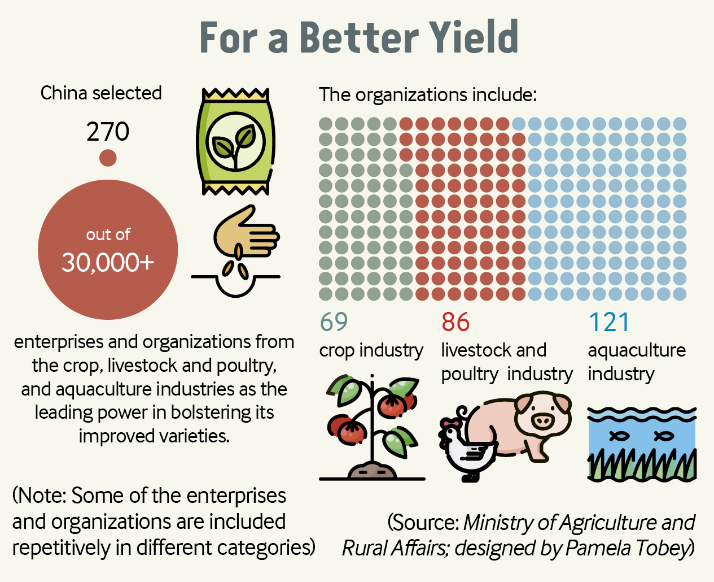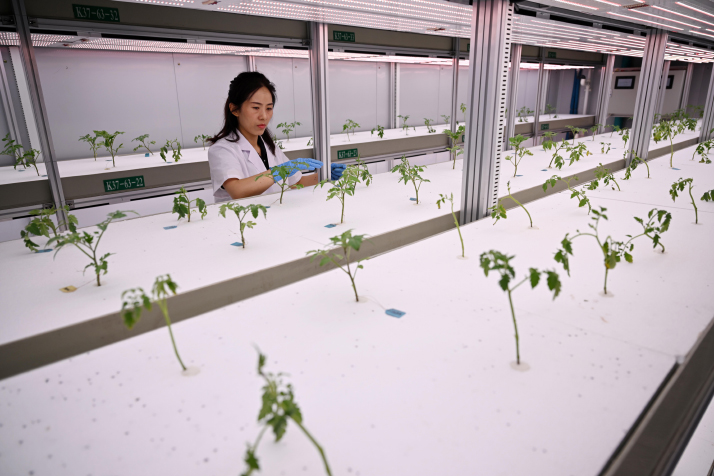| China |
| The 'Chips' of Farming | |
|
|
  A staff member takes care of seedlings in a workshop on intelligent plant growing at a seed exhibition in Yinchuan, Ningxia Hui Autonomous Region on July 27 (XINHUA)
Xichang has been known as "the land of onion" since the 1990s when large-scale production of the vegetable began in the southwestern city in Sichuan Province. Nevertheless, the onions were grown from seeds imported from the U.S., Japan and some European countries, which cost 400 yuan ($48 at the then exchange rate) per kg on average. Things changed when Xicong No.1, a red onion variety, was developed by Chinese agronomists in 2004, breaking the foreign monopoly and lowering the cost of seeds by 75 percent. Behind the breakthrough was Li Chengzuo, a local college lecturer who led an onion breeding project. With limited research expenditure, Li and other researchers had to borrow facilities for their trials in the beginning until they received their first funding of 20,000 yuan ($2,430 at the then exchange rate) from the local authorities in 1998. The project took the team almost 10 years to complete. In 2008, Li founded Xichang Kewei Onion Seed Co. Ltd. and since then has developed more than 50 onion varieties. They are not only grown in Xichang but also introduced to other parts of China as well as more than 20 Southeast Asian and African countries. On August 4, Xichang Kewei appeared on a list of 270 enterprises and organizations that are leading China's improvement of crop, livestock, poultry and aquaculture varieties. "To build a prosperous seed industry, it's necessary to give support to the enterprises that are capable of innovation and meet the needs of the market," the Ministry of Agriculture and Rural Affairs (MARA) said when unveiling the list, adding that these enterprises will become the mainstay of the country's seed development efforts. Key to Success According to the MARA, China uses 10 billion kg of seeds every year for planting, and the annual breeding demand of its animal husbandry and fishery sectors includes 600 million piglets, 15 billion chicks and 6 trillion aquatic fries. "Enterprises are main driving forces of technological progress in the seed industry," Jing Fei, head of the School of Management at Bohai University, told Beijing Review. The market plays a decisive role in the resource allocation in the sector and companies matter a lot in the process, he added. "A virtuous cycle should be created for the high-quality development of the seed industry, whereby higher corporate profits from innovative products will lead to greater research and development (R&D) investment," Jing said. Li's company adopted this model. In 2015, he established an institute for research and began putting a larger portion of the company's profits back into its R&D programs. "Enterprises are market-oriented and regard agricultural production and actual use as their guide. However, currently, Chinese seed companies are smaller in size and technologically weaker compared with international leading players," Li Guoxiang, a researcher with the Rural Development Institute at the Chinese Academy of Social Science, told People's Daily, He added that many Chinese firms have realized the significance of seed breeding whereas not all of them have the corresponding R&D capacity. A model of industry-university-research integration rose in response. Aside from companies, the MARA list also included R&D organizations, universities and professional platforms to form a dynamic system. The government will jump in when support is needed. In July 2021, the 20th meeting of the central commission for deepening overall reform reviewed and approved an action plan on vitalizing the seed industry. In February, the first policy document released by the central authorities this year outlined seed industry development as one of China's priorities. On March 1, the revised Seed Law went into effect, expanding the scope of IPR protection for new varieties. The country is also moving forward in its ever largest survey of crop, livestock, poultry and aquatic resources, which started in March 2021. According to the MARA, the government will take measures to encourage seed companies to cooperate with R&D and financial institutions, as well as seed bases. Supporting policies will follow to give them access to participation in the protection, identification and utilization of agricultural genetic resources. With this support, the selected enterprises will take the lead in tackling critical problems and conducting seed projects, the ministry said. They are divided into three categories according to different tasks. Li's company, together with some other vegetable seed firms, will focus on enhancing industry-university-research cooperation and fostering proprietary varieties as an alternative to imported ones. Some, including corn and soybean seed companies, will go all out to narrow the gap of their products with international leaders in terms of production, performance and quality. Others, such as rice and wheat seed companies, have been asked to speed up the application of modern breeding technologies, consolidate their advantages and commercialize the breeding system. Reform Goals "In developed countries, the most prominent trait of successful seed companies lies in their capacity to integrate scientific research, production, marketing and investment, which facilitates the application of innovative outcomes," the MARA said, outlining the development goals for domestic companies. "We can learn from advanced countries from two perspectives," Jing said. One is to foster globally competitive corporations. Chinese seed firms should learn how giant multinationals like Bayer and Corteva grew up. The other is to build a sound industrial system. Seed companies, R&D institutions with different strengths and other market entities involved should all be performing their appropriate functions in the ecosystem. "The development of the seed industry is a systematic program," Jing said. He calls for a mechanism to channel the necessary support from universities, R&D and financial institutions, and government organizations to enterprises. It is also vital to turn institutions engaged in applicable research into companies to make their R&D programs more market-oriented. Moreover, the demand for region-specific seeds is huge in China given its various climate conditions and diversified farming systems. The MARA list therefore should be further expanded to cover more developers of these seeds. Jing believes in combining competition with cooperation, saying that it's important to speed up mergers and reorganizations to avoid the repetitive investment and promote the sharing of professional personnel, platforms and resources. China should also expand cooperation with other countries on the sharing and utilization of genetic resources, according to him. Scientists dream big. Li has realized his dream of cultivating Chinese onion varieties. Now, his dream is to make Xichang a global onion R&D powerhouse. "We still have a long way to go," Li told local broadcaster Xichang TV. "We will keep breeding new varieties, strive to build a Xichang-centered onion seed breeding, storage and supply chain, and improve our techniques to an internationally leading level." BR Copyedited by G.P. Wilson Comments to zhangshsh@cicgamericas.com |
|
||||||||||||||||||||||||||||
|
